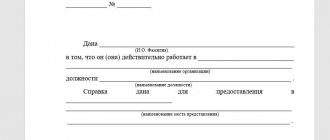The procedure for dismissing employees is determined by the reasons for which you have to say goodbye to them. In some cases, advance notice is considered mandatory, and the period from the moment of such warning is specified by law, before the expiration of which the person cannot be fired. And if the employer fails to comply with all associated legal requirements, he should be prepared to pay legal costs. But it’s better to do everything right and thereby avoid possible problems.
- 5.1 Notification of bailiffs about the debtor’s dismissal
5.2.1 Notification of the migration authority about the dismissal of a foreigner (video)
In what cases should an employee be notified of dismissal?
The Labor Code (LC) of the Russian Federation contains a direct requirement to notify the employee of the upcoming dismissal in relation to a number of reasons for separation. These include:
- Liquidation of company;
- staff reduction;
- failure to complete the probationary period;
- expiration of the employment contract.
In practice, notifications, regardless of the reason for dismissal, are sent to remote workers, since there is often no other way to communicate with them.
Notifications may also be sent to employees dismissed for absenteeism. After all, if a person does not show up at work for a long time and does not get in touch, the employer must, before making a decision, try to contact him himself and be ready, if necessary, to confirm this in court. In such a situation, it is logical, after several attempts to contact the employee, to inform him in writing that he was fired because he never showed up at work and did not let anyone know about himself.
In other cases of dismissal for disciplinary offenses, other documents are used as the basis for issuing the corresponding order: acts of internal investigation, official and memos, acts of medical examination, if the reason for dismissal is showing up at work under the influence or organizing drunkenness in the workplace, etc. P.
Sample letter to an employee who does not show up for work as part of the dismissal procedure for absenteeism
Standards for replacing a fine with a warning: sample
According to current legislation, the guilty person must be punished for administrative offenses in the form of an administrative penalty. Depending on the severity of the unlawful act, various forms of liability can be used - from warnings to the imposition of particularly large fines. In certain cases, it is possible to replace monetary punishment with official censure of an individual or legal entity. Let us examine in more detail the features of this procedure.
Representatives of small and medium-sized businesses (entrepreneurs, legal entities), as well as employees of the listed organizations, can avoid paying an administrative fine.
Such a replacement is possible only under certain conditions:
- the fact of violation by the guilty person has been proven for the first time;
- current legislation provides for mitigation of punishment in a specific case (in the form of a written notice);
- the offender by his actions did not endanger the life and health of people, as well as the external environment;
- no material damage was caused to third parties.
Release of the guilty person from a monetary penalty is possible only if all the above requirements are met simultaneously. An administrative fine can only be replaced through a judicial procedure. To do this, it is necessary to submit an application to a court authorized to directly investigate and establish in a court session the circumstances of the case (first instance) or a body for reviewing cases, decisions and sentences for which have not yet entered into legal force (court of appeal).
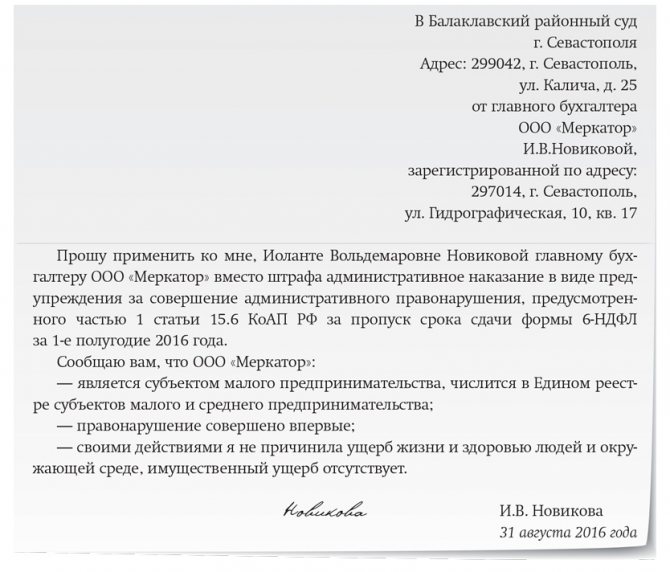
How long before dismissal must notice be given?
In cases where it is necessary to notify an employee that the employer intends to dismiss him, the law also stipulates specific deadlines, which are:
- two months in case of staff reduction and liquidation of the organization;
- three days upon expiration of the employment contract and failure to complete the probationary period.
A special case is the dismissal of a woman whose fixed-term contract at the time of its expiration had to be extended due to pregnancy. When she returns to work after the end of her pregnancy or the end of her maternity leave, she must be notified of her dismissal a week in advance.
How to correctly draw up and execute a notice of dismissal
The notice of upcoming dismissal must contain the following information:
- name of the employer (its letterhead can be used, if available);
- Full name, position of the dismissed employee, structural unit in which he is registered;
- information about dismissal: date, reason;
- date of the notification;
- Full name, position and signature of the head of the organization;
- seal of the organization, if any;
- the employee’s note on delivery of the notice with the date and his personal signature.
The notice may also indicate the number and date of conclusion of the employment contract of the dismissed employee. If the reason for the dismissal was a reduction in staff, it makes sense to list in the text all the positions indicating the salary that the company can offer to the person being laid off. If there are no such positions, this must be reflected in the document. After all, when downsizing, the law requires that candidates for dismissal be offered all available vacant positions that will not be affected by the optimization of the staffing table. Including those assuming a lower level of qualifications and/or salary than the current one. The employee is not obliged to agree to any of them, but the employer must offer them to him.
When staffing is reduced, the notice may contain a proposal for dismissal earlier than the two-month period required by law. If the employee agrees to this, the employer is obliged to pay him the average salary for these unworked months in addition to severance pay and other compensation provided in this case.
The notice is drawn up in two copies. One of them is given to the employee, the second, with his signature, remains with the employer. If the notice is sent to the employee by mail, both copies are sent to him. Having signed one, he must return it to the employer in any convenient way.
Samples of notices of dismissal for various reasons (photo gallery)
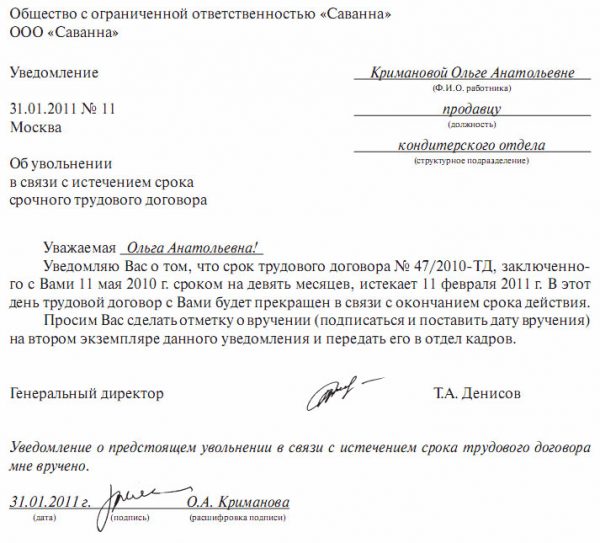
Sample notice of dismissal due to expiration of an employment contract
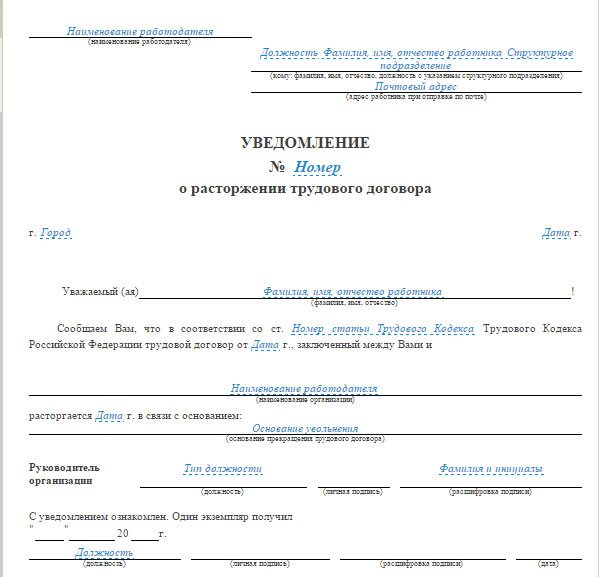
Sample notification in connection with the expiration of an employment contract, option No. 2
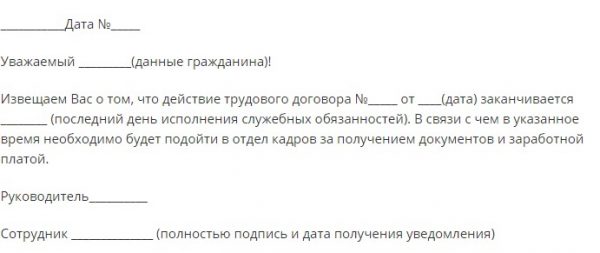
Sample notification in connection with the expiration of an employment contract, option No. 3
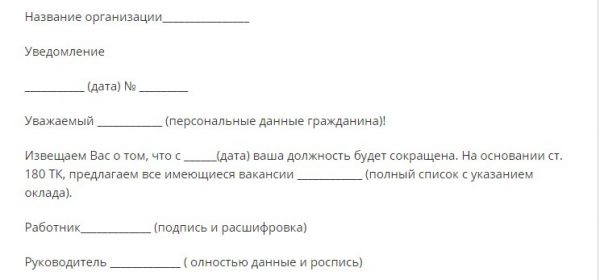
Sample notice of dismissal due to staff reduction, option No. 1

Sample notice of staff reduction, option No. 2

Sample letter of dismissal due to expiration of the employment contract, option No. 4

Sample notice of dismissal for absenteeism
Sample notification of an employee who has not completed the probationary period (photo gallery)
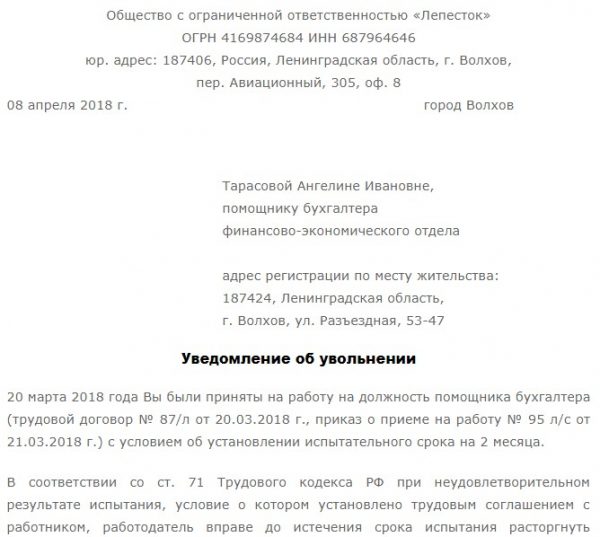
Sample notice of dismissal due to failure to complete the probationary period, part 1
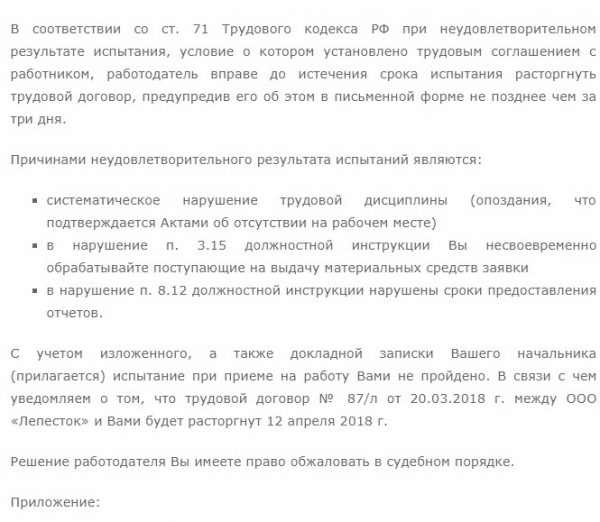
Sample notice of dismissal due to failure to complete the probationary period, part 2

Sample notice of dismissal due to failure to complete the probationary period, part 3
Features of writing warnings: sample document
Requirements for document execution may vary depending on the accounting policies of the organization. Still, there are several universal rules for drawing up a written warning.
The notice must contain the following information:
- Full names of all parties involved;
- nature of the incident;
- exact date and time of the event;
- a list of previously issued written notices, including the period, time, and a list of related persons;
- instructions for correcting the situation.

The warning must also contain information about the consequences of further violations. For example, an employee may be fired for subsequent failure to comply with labor discipline. Notice can be delivered in several ways:
- by courier;
- by an authorized employee if the warning was issued within the enterprise;
- email, text message and other means of communication.
But using the latter method often reduces the severity of the notification.
One of the main rules of business correspondence is the timeliness of document execution, so issuing a warning should be carried out immediately after the incident. To confirm his agreement with the terms of the agreement, the recipient must sign one of the copies of the written warning.
Let's consider a sample written warning about termination of a fixed-term employment contract.
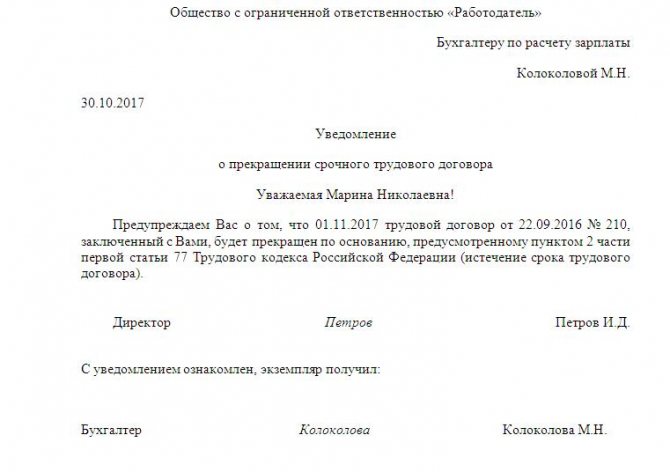
What to do if an employee refuses to sign a notice of dismissal
To deliver notice of the upcoming dismissal, an employee is most often invited to his office by an employee who is responsible for maintaining personnel records in the organization. It is also possible that this specialist himself comes to the workplace of the person being dismissed to give him the document.
Other scenarios are also allowed: transfer the notification through the secretary, office, immediate supervisor, or call to the first person in the organization, who will hand over the notification personally.
With remote workers, it all depends on where they live. If, for example, they live in the Moscow region in the same city where the employer’s office is located or not far from it, and the company is based in Moscow, there is no problem inviting them to the HR department. Otherwise, all interaction is carried out by mail. In this case, preliminary notification of the employee can be done by email, by phone, or via instant messenger. But for better provability when carrying out key formalities, it is better to use Russian Post.
Throughout my own career, I have more than once had to receive fateful personnel documents, including those related to the upcoming dismissal. In large companies or small ones, but dating back to Soviet times and faithful to the traditions of intradepartmental bureaucracy laid down in those years, for this purpose they were usually invited to the personnel department. In small businesses, which originated in post-Soviet times, key personnel issues were most often resolved in a conversation with the head of the organization. And the accounting department or secretary, who was entrusted with office work, was assigned the purely role of paperwork for decisions made in the chief’s office. In the company where I worked on the eve of the 2008 crisis, I was not required to come to the office every day. But since both I and the company were in Moscow, we were invited to the office to resolve key issues. This happened during the massive staff reduction: we were called to a meeting where they told us the news, and then they began to invite us one by one to the HR department to sign documents.
If the employee refuses to receive notification of this, an act () is drawn up.
The act must reflect:
- date, number and name - act;
- employer's name;
- Full name, position of the employee and the structural unit to which he is registered;
- Full name and position of the person who drew up the act;
- Full name and position of the witnesses in whose presence the events reflected in the act took place;
- the date, place and time of the event and its key details - where, when and who tried to give notice to the dismissed person and how it ended;
- signatures of the employee who drew up the act and witnesses.
There must be at least two witnesses. The act must be read out loud to the employee in their presence. After this, the dismissed person will be considered familiar with the document, despite the lack of a signature.
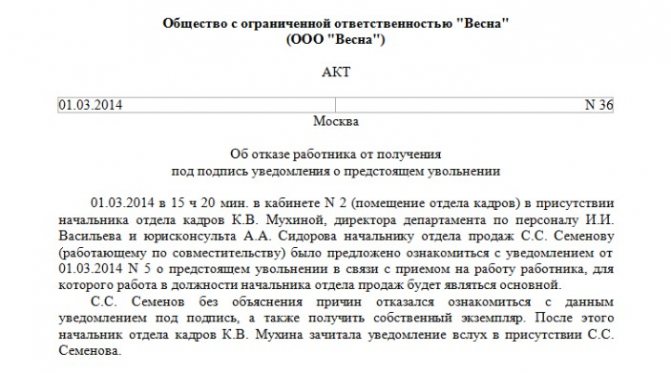
Sample act of refusal of an employee to receive notice of dismissal
If a dismissed person does not show up for work or works remotely and ignores invitations from the HR department or cannot appear there for valid reasons, the employer sends a notice to his home address by mail. After this, the obligation to warn about the upcoming dismissal will be considered fulfilled, even if the employee does not come to the post office for it or the address held by the company turns out to be irrelevant.
Sample of official notice of debt
Late utility payments have serious consequences. Owners of apartments and private houses can be evicted from their own homes if they do not pay for electricity for more than six months.
There are several reasons for debt:
- temporary financial difficulties;
- complete loss of ability to work;
- lack of proper control by representatives of utility services;
- controversial situations and litigation, where the second party is the utility service.
If funds are not received into the account on time, the company may apply several collection methods to the defaulter:
- Written warning. If the recipient of the notice pays off the entire debt within the specified period, the case will be closed.
- If there is no payment for a long time, utility services may charge a penalty. The amount of the penalty for failure to fulfill obligations will increase until the debt is repaid. A penalty may be accrued without a corresponding court decision and prior notification to the debtor.
- The violator may also have the service cut off. The defaulter must repay the debt within a month. Company representatives will resume utility services within 48 hours after full payment of obligations and penalties.
- Utility services resort to litigation if there is no payment for a long period - several months or years. ·

There are several ways to send a debt alert:
- "Russian Post";
- by courier;
- personal delivery by an authorized employee.
The document must contain the following information:
- full address, full name of the defaulter;
- amount of debt;
- the amount of the penalty;
- information about further actions in case of refusal to repay obligations;
- proposal to discuss the reason for the delay and further actions with representatives of utility services;
- list of authorized officials of the utility service, their signatures.
It is also permitted to use other information in the notice. For example, utility services may make concessions and cancel previously accrued penalties.
Notification of government agencies about the dismissal of an employee
In some cases, the employer is obliged to notify government agencies of the employee’s dismissal. These include:
- notification to the Federal Bailiff Service (FSSP) in the event of dismissal of a debtor, from whose salary deductions are made in pursuance of court decisions, requirements of the tax inspectorate and the Pension Fund, etc.;
- territorial division of the Main Directorate for Migration Issues (GUVM) of the Ministry of Internal Affairs of the Russian Federation upon the dismissal of a foreigner;
- military registration and enlistment office at the place of military registration of the person being dismissed upon dismissal of a person liable for military service;
- employment services in case of staff reduction or liquidation of a company.
Notification of bailiffs about the debtor's dismissal
The exact timing of informing bailiffs about the dismissal of an employee from whose salary the employer made deductions through their department is not provided for by current legislation. The only requirement is to do this immediately. An exception is provided only for alimony payers - bailiffs must be informed of their dismissal within three days. But in other cases, it is better not to delay, but to send the notice, if possible, directly on the last working day of the dismissed person.
If the employer forgets to do this, he faces a fine of 15–20 thousand rubles for the official and 50–100 thousand rubles for the company.
The notification must indicate:
- Full name and position of the bailiff to whom it is addressed (this data and contacts of the FSSP unit are taken from the relevant documents on the basis of which deductions are made);
- employer's name (you can use letterhead if you have one);
- Full name and position of the dismissed debtor;
- date of dismissal;
- grounds for dismissal - number and date of the relevant order;
- information where the dismissed person now works, or that the employer does not have this information;
- date of preparation of the notification to the FSSP;
- Full name, position and signature of the head of the company.
Along with the notification, a writ of execution with notes on the deductions made is sent to the FSSP unit.

Sample FSSP notice of dismissal of a debtor
Notification of the Main Directorate of Migration Affairs of the Ministry of Internal Affairs about the dismissal of a foreigner
The employer must send a notification to the migration authority within three days after his dismissal. This can be done by personally visiting the territorial unit of the Main Department of Migration Affairs of the Ministry of Internal Affairs at the place of registration of the company, or by mail.
To do this, fill out the form () of the established form.

Sample of filling out a notification from the Main Directorate of Migration Affairs of the Ministry of Internal Affairs about the dismissal of a foreigner
For violation of this legal requirement, fines are imposed: 5-7 thousand rubles for individuals, 35-70 thousand rubles for officials and 400 thousand - 1 million rubles for organizations.
Sample order (instruction) on warning
The issuance of warning orders to employees of commercial structures for violation of labor discipline is not provided for by current legislation.
In this case, several types of disciplinary sanctions may be applied to employees of private companies:
- comment;
- rebuke;
- dismissal.
The use of other forms of punishment is also permitted, but only within the framework of federal laws or enterprise charters. For example, employees of government agencies may receive a warning about professional inconsistency.
Such an order must include several mandatory parts:
- a summary of the violation;
- evidence base (in this section you should provide links to internal documents, laws, memos);
- the manager's decision on the type of disciplinary punishment.








